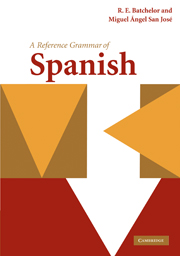Book contents
- Frontmatter
- Contents
- Preface/Prólogo
- Acknowledgments/Agradecimientos
- Abbreviations/Abreviaturas
- Introduction to the Spanish language/Introducción a la lengua española
- Part I
- Part II
- Part III
- Part IV
- Part V
- Part VI
- Part VII
- Part VIII
- Part IX
- Part X
- Appendix I Verb tables/ Tablas de verbos
- Appendix II Glossary/Glosario
- Bibliography/Bibliografía
- General index/Índice general
- Subjunctive index/Índice del subjuntivo
Preface/Prólogo
Published online by Cambridge University Press: 05 June 2012
- Frontmatter
- Contents
- Preface/Prólogo
- Acknowledgments/Agradecimientos
- Abbreviations/Abreviaturas
- Introduction to the Spanish language/Introducción a la lengua española
- Part I
- Part II
- Part III
- Part IV
- Part V
- Part VI
- Part VII
- Part VIII
- Part IX
- Part X
- Appendix I Verb tables/ Tablas de verbos
- Appendix II Glossary/Glosario
- Bibliography/Bibliografía
- General index/Índice general
- Subjunctive index/Índice del subjuntivo
Summary
This volume is designed to provide a clear, practical and comprehensive guide to the grammar of the Spanish language. It surveys the grammatical structures, not only of Spain but also of the Americas. Any complete survey of Spanish grammar must needs attempt to cover both the language as it appears in the Iberian peninsula and the language that stretches from the Mexican border with the United States (from the Río Bravo = Río Grande in Iberian Spanish) to the southern tip of Argentina (Tierra del Fuego). In other words, it roams over vast territories in the examination and analysis of a language that mingles with, and derives a rich source of expansion from, indigenous tongues like the Quechua of the Bolivians or Peruvian Incas, or the Nahuatl of the Mexican Aztecs and Mayas of Central America, or even the Palenquero, a creole language in Colombia. However, rather than devoting unnecessarily an excess of print to the grammar of every Spanish- speaking country as though they all suggested different grammatical configurations, or simply referring to an item in an often misleading blanket fashion as “Amer.”, it was deemed wiser to concentrate on four countries – strategically placed, linguistically speaking – since these will suffice to emphasize the relative uniformity of most, if not all, of them. The four countries in question are Spain, first of all, given the history of the language; followed by Mexico (M), the most populous of Spanish- speaking countries forming part of North America; Colombia (C), a large country, four times the size of France, in the north- west of South America; and finally Argentina (A), representative of the Southern Cone.
- Type
- Chapter
- Information
- A Reference Grammar of Spanish , pp. xi - xiiPublisher: Cambridge University PressPrint publication year: 2010

